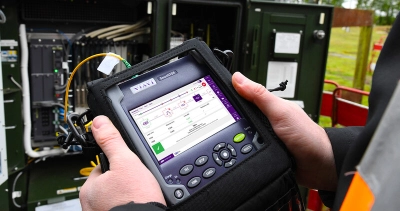Discover the Value of Optical Fiber Testing in Modern Telecom
In the world of modern-day telecoms, the value of optical fiber screening can not be overemphasized, as it offers as the backbone for guaranteeing network dependability and performance. What are the particular benefits that normal screening offers, and how might it shape the future landscape of telecoms?

Understanding Optical Fiber Screening
Optical fibre screening is an essential procedure in telecommunications that ensures the honesty and efficiency of fibre optic networks. This screening includes a variety of procedures made to examine the physical and practical attributes of optical fibers - optical fibre diameter analyser. Secret parameters examined include optical power loss, data transfer capability, and mistake area, which are essential for keeping top notch communication web links
The testing procedure generally entails using specific equipment such as Optical Time-Domain Reflectometers (OTDR) and Optical Power Meters. OTDRs are utilized to recognize and define mistakes, entwines, and connectors within the fiber, while power meters measure the transmitted light signal stamina to identify efficiency.
In addition, screening is conducted at numerous phases, consisting of throughout installation, maintenance, and troubleshooting, to make certain that the network meets market criteria and operational demands. Conformity with requirements established by organizations like the International Telecommunication Union (ITU) and the Telecommunications Market Organization (TIA) is critical.
Benefits of Regular Evaluating
Normal screening of optical fibers returns numerous advantages that significantly improve network dependability and efficiency. One of the main advantages is the very early discovery of possible issues, such as breaks or degradation in the fibre, which can bring about costly downtime if left unaddressed (fibre testing equipment). By determining these troubles proactively, telecoms providers can minimize service disruptions and make sure regular connection for their consumers
Additionally, routine testing assists to preserve the integrity of signal quality. As optical fibres age, their performance can be impacted by elements such as environmental conditions and physical stress. Routine assessments permit the monitoring of signal loss and overall transmission efficacy, guaranteeing that the network operates at ideal degrees.
Another substantial advantage is conformity with industry criteria. Routine testing sustains adherence to regulative needs, consequently mitigating lawful and financial dangers associated with non-compliance. It enhances the general lifespan of the fibre framework by facilitating prompt upkeep and repairs.

Common Checking Approaches
Testing optical fibres utilizes numerous approaches to guarantee the stability and efficiency of telecoms networks. Among the most common methods is Optical Time Domain Name Reflectometry (OTDR), which analyzes the whole size of the fibre by sending a pulse of light and determining the representations brought on by imperfections or breaks. This technique provides comprehensive information concerning the location and extent of mistakes.
An additional common method is using Optical Power Meters, which gauge the quantity of light transferred with the fiber. This method assists figure out the loss of signal toughness, making sure that it satisfies market requirements. Furthermore, Visual Fault Locators (VFL) are employed to identify breaks or severe bends in the fiber by predicting a noticeable laser light right into the cable television.
Insertion loss testing is also essential, as it evaluates the loss of signal power arising from connections and entwines within the network. The usage of Polarization Mode Dispersion (PMD) screening examines the effect of fibre characteristics on signal stability.
Each of these techniques plays an important role in keeping the efficiency and reliability of optical fiber networks, ultimately adding to smooth telecommunications operations.
Effect On Network Performance
The integrity and performance of optical fiber networks directly influence overall network efficiency. In contemporary telecoms, the effectiveness of information transmission counts heavily on the high quality of the optical fibres utilized. Any kind of destruction in the fibre's problem-- whether due to physical damages, contamination, or excessive flexing-- can cause boosted depletion and signal loss, dramatically influencing data stability and rate.
Normal optical fibre screening is necessary to recognize and rectify potential issues prior to they manifest as network failings or visit the website stagnations. Strategies such as Optical Time Domain Name Reflectometry (OTDR) and insertion loss testing allow service technicians to gauge the performance of fiber links accurately. These examinations not just evaluate the physical condition of the fibres yet likewise make certain compliance with sector standards, consequently safeguarding the network's dependability.
Additionally, a properly maintained optical fiber network contributes to decreased operational expenses and improved customer satisfaction, as end-users experience fewer disturbances and greater data rates. Eventually, the emphasis on strenuous optical fibre testing techniques functions as a keystone for sustaining durable telecoms facilities, making certain that solution carriers can meet the growing demands for data transfer and connectivity in today's digital age.
Future Fads in Evaluating
As we look ahead, advancements in modern you can check here technology are positioned to reshape optical fibre screening in telecommunications. The increase of automation and man-made knowledge (AI) is expected to improve the performance and accuracy of testing procedures. Automated testing systems can carry out extensive evaluations with very little human treatment, substantially reducing the possibility for errors and speeding up time-to-deployment.
Furthermore, the integration of maker discovering formulas will allow anticipating maintenance, enabling network service providers to foresee possible issues before they rise into failures. This aggressive method not only enhances network reliability yet likewise maximizes functional expenses.
An additional arising pattern is the advancement of portable screening gadgets that provide real-time analysis - optical fibre testing equipment. These devices will empower service technicians to execute on-site diagnostics swiftly, promoting quicker resolutions and improving solution top quality
The growth of 5G networks further necessitates the advancement of testing methodologies. As transmission capacity demands raise, traditional screening strategies may no more are adequate. Cutting-edge solutions such as optical time-domain reflectometry (OTDR) and advanced spectral analysis will become crucial in making sure the stability and efficiency of high-speed connections.

Verdict
To conclude, optical fibre screening is crucial for making sure the integrity and integrity of contemporary telecommunications networks. Regular screening techniques not only aid recognize prospective problems such as signal loss and faults yet additionally contribute to improved network efficiency and consumer complete satisfaction. As the pop over to this web-site demand for seamless connectivity remains to grow, the fostering of innovative testing methods will certainly play a vital function in maintaining high-quality network criteria and supporting the developing landscape of telecommunications.
 Mr. T Then & Now!
Mr. T Then & Now! Tatyana Ali Then & Now!
Tatyana Ali Then & Now! Joshua Jackson Then & Now!
Joshua Jackson Then & Now! Shannon Elizabeth Then & Now!
Shannon Elizabeth Then & Now! Jeri Ryan Then & Now!
Jeri Ryan Then & Now!